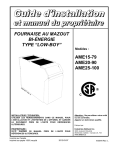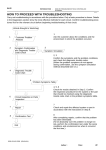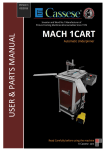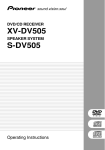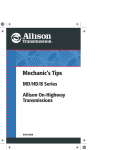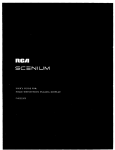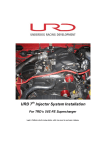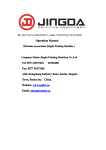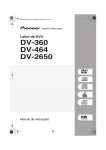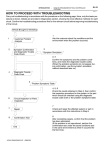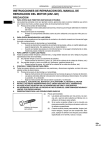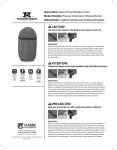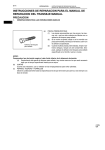Download 1996 TOYOTA T100 Factory Service Manual
Transcript
1996 TOYOTA T100 Factory Service Manual INDEX IN MA PP SS DI EM EC MF SF CO LU IG ST CH CL MT AT TR PR SA BR SR RS BE BO AC Introduction Maintenance Preparation Service Specifications Diagnostics Engine Mechanical (3RZ-FE) Engine Mechanical (5VZ-FE) Emissions Control (3RZ-FE) Emissions Control (5VZ-FE) MFI System (3RZ-FE) SFI System (5VZ-FE) Cooling (3RZ-FE) Cooling (5VZ-FE) Lubrication (3RZ-FE) Lubrication (5VZ-FE) Ignition (3RZ-FE) Ignition (5VZ-FE) Starting (3RZ-FE) Starting (5VZ-FE) Charging (3RZ-FE) Charging (5VZ-FE) Clutch Manual Transmission (R150, R150F) Manual Transmission (W59) Automatic Transmission Transfer Propeller Shaft Suspension and Axle Brake Steering Supplemental Restraint System Body Electrical Body Air Conditioning IN – INTRODUCTION HOW TO USE THIS MANUAL IDENTIFICATION INFORMATION REPAIR INSTRUCTIONS FOR ALL OF VEHICLES HOW TO TROUBLESHOOT ECU CONTROLLED SYSTEMS TERMS IN-1 IN-3 IN-4 IN-9 IN-15 IN-31 IN−1 INTRODUCTION − HOW TO USE THIS MANUAL HOW TO USE THIS MANUAL IN02D−02 GENERAL INFORMATION 1. INDEX An INDEX is provided on the first page of each section to guide you to the item to be repaired. To assist you in finding your way through the manual, the Section Title and major heading are given at the top of every page. 2. PRECAUTION At the beginning of each section, a PRECAUTION is given that pertains to all repair operations contained in that section. Read these precautions before starting any repair task. 3. TROUBLESHOOTING TROUBLESHOOTING tables are included for each system to help you diagnose the problem and find the cause. The fundamentals of how to proceed with troubleshooting are described on page IN−16. Be sure to read this before performing troubleshooting. 4. PREPARATION Preparation lists the SST (Special Service Tools), recommended tools, equipment, lubricant and SSM (Special Service Materials) which should be prepared before beginning the operation and explains the purpose of each one. 5. REPAIR PROCEDURES Most repair operations begin with an overview illustration. It identifies the components and shows how the parts fit together. Example: Filler Cap Float Clevis Pin z Gasket Reservoir Tank Boot z Grommet Slotted Spring Pin Clip 12 ( 120, 9) Clevis 15 ( 155, 11) Snap Ring Washer Piston Lock Nut Push Rod Cylinder N·m (kgf·cm, ft·lbf) : Specified torque z Non−reusable part N17080 1996 TOYOTA T100 (RM449U) Author: Date: 1 IN−2 INTRODUCTION − HOW TO USE THIS MANUAL The procedures are presented in a step−by−step format: S The illustration shows what to do and where to do it. S The task heading tells what to do. S The detailed text tells how to perform the task and gives other information such as specifications and warnings. Example: Task heading : what to do 21. CHECK PISTON STROKE OF OVERDRIVE BRAKE (a) Place SST and a dial indicator onto the overdrive brake piston as shown in the illustration. SST 09350−30020 (09350−06120) Illustration: what to do and where Set part No. Detailed text : Component part No. how to do task (b) Measure the stroke applying and releasing the compressed air (392 − 785 kPa, 4 − 8 kgf.cm2 or 57 − 114 psi) as shown in the illustration. Piston stroke: 1.40 1.70 mm (0.0551 0.0669 in.) Specification This format provides the experienced technician with a FAST TRACK to the information needed. The upper case task heading can be read at a glance when necessary, and the text below it provides detailed information. Important specifications and warnings always stand out in bold type. 6. REFERENCES References have been kept to a minimum. However, when they are required you are given the page to refer to. 7. SPECIFICATIONS Specifications are presented in bold type throughout the text where needed. You never have to leave the procedure to look up your specifications. They are also found in Service Specifications section for quick reference. 8. CAUTIONS, NOTICES, HINTS: S CAUTIONS are presented in bold type, and indicate there is a possibility of injury to you or other people. S NOTICES are also presented in bold type, and indicate the possibility of damage to the components being repaired. S HINTS are separated from the text but do not appear in bold. They provide additional information to help you perform the repair efficiently. 9. SI UNIT The UNITS given in this manual are primarily expressed according to the SI UNIT (International System of Unit), and alternately expressed in the metric system and in the English System. Example: Torque: 30 N·m (310 kgf·cm, 22 ft·lbf) 1996 TOYOTA T100 (RM449U) Author: Date: 2 IN−3 INTRODUCTION − IDENTIFICATION INFORMATION IDENTIFICATION INFORMATION VEHICLE IDENTIFICATION AND ENGINE SERIAL NUMBER IN02E−02 1. VEHICLE IDENTIFICATION NUMBER The vehicle identification number is stamped on the vehicle identification number plate and certification label, as shown in the illustration. A: Vehicle Identification Number Plate B: Certification Label A 2. ENGINE SERIAL NUMBER The engine serial number is stamped on the engine block as shown, in the illustration. B13830 1996 TOYOTA T100 (RM449U) Author: Date: 3 IN−4 INTRODUCTION − REPAIR INSTRUCTIONS REPAIR INSTRUCTIONS GENERAL INFORMATION FI1066 BASIC REPAIR HINT (a) Use fender, seat and floor covers to keep the vehicle clean and prevent damage. (b) During disassembly, keep parts in the appropriate order to facilitate reassembly. (c) Observe the following operations: (1) Before performing electrical work, disconnect the negative (−) terminal cable from the battery. (2) If it is necessary to disconnect the battery for inspection or repair, always disconnect the negative (−) terminal cable which is grounded to the vehicle body. (3) To prevent damage to the battery terminal, loosen the cable nut and raise the cable straight up without twisting or prying it. (4) Clean the battery terminals and cable ends with a clean shop rag. Do not scrape them with a file or other abrasive objects. (5) Install the cable ends to the battery terminals with the nut loose, and tighten the nut after installation. Do not use a hammer to tap the cable ends onto the terminals. (6) Be sure the cover for the positive (+) terminal is properly in place. (d) Check hose and wiring connectors to make sure that they are secure and correct. (e) Non−reusable parts (1) Always replace cotter pins, gaskets, O−rings and oil seals etc. with new ones. (2) Non−reusable parts are indicated in the component illustrations by the ”z” symbol. (f) Seal Lock Adhesive Z11554 IN0IL−01 Precoated parts Precoated parts are bolts and nuts, etc. that are coated with a seal lock adhesive at the factory. (1) If a precoated part is retightened, loosened or caused to move in any way, it must be recoated with the specified adhesive. (2) When reusing precoated parts, clean off the old adhesive and dry with compressed air. Then apply the specified seal lock adhesive to the bolt, nut or threads. 1996 TOYOTA T100 (RM449U) Author: Date: 4 IN−5 INTRODUCTION − REPAIR INSTRUCTIONS (3) (g) (h) (i) Medium Current Fuse and High Current Fuse Equal Amperage Rating (j) Precoated parts are indicated in the component illustrations by the ”L” symbol. When necessary, use a sealer on gaskets to prevent leaks. Carefully observe all specifications for bolt tightening torques. Always use a torque wrench. Use of special service tools (SST) and special service materials (SSM) may be required, depending on the nature of the repair. Be sure to use SST and SSM where specified and follow the proper work procedure. A list of SST and SSM can be found in the preparation part at the front of each section in this manual. When replacing fuses, be sure the new fuse has the correct amperage rating. DO NOT exceed the rating or use one with a lower rating. BE1367 Illustration Symbol Part Name Abbreviation FUSE FUSE MEDIUM CURRENT FUSE M−FUSE HIGH CURRENT FUSE H−FUSE FUSIBLE LINK FL CIRCUIT BREAKER CB V00076 1996 TOYOTA T100 (RM449U) Author: Date: 5 IN−6 INTRODUCTION (k) (l) WRONG (3) (4) (5) IN0253 WRONG (6) CORRECT (7) (8) IN0252 (m) Example REPAIR INSTRUCTIONS Care must be taken when jacking up and supporting the vehicle. Be sure to lift and support the vehicle at the proper locations (See page IN−8). (1) If the vehicle is to be jacked up only at the front or rear end, be sure to block the wheels at the opposite end in order to ensure safety. (2) After the vehicle is jacked up, be sure to support it on stands. It is extremely dangerous to do any work on a vehicle raised on a jack alone, even for a small job that can be finished quickly. Observe the following precautions to avoid damage to the following parts: (1) Do not open the cover or case of the ECU, ECM, PCM or TCM unless absolutely necessary. (If the IC terminals are touched, the IC may be destroyed by static electricity.) (2) CORRECT − To disconnect vacuum hoses, pull off the end, not the middle of the hose. To pull apart electrical connectors, pull on the connector itself, not the wires. Be careful not to drop electrical components, such as sensors or relays. If they are dropped on a hard floor, they should be replaced and not reused. When steam cleaning an engine, protect the electronic components, air filter and emission−related components from water. Never use an impact wrench to remove or install temperature switches or temperature sensors. When checking continuity at the wire connector, insert the tester probe carefully to prevent terminals from bending. When using a vacuum gauge, never force the hose onto a connector that is too large. Use a step−down adapter for adjustment. Once the hose has been stretched, it may leak. Tag hoses before disconnecting them: (1) When disconnecting vacuum hoses, use tags to identify how they should be reconnected to. (2) After completing a job, double check that the vacuum hoses are properly connected. A label under the hood shows the proper layout. IN0002 1996 TOYOTA T100 (RM449U) Author: Date: 6 IN−7 INTRODUCTION (n) − REPAIR INSTRUCTIONS Unless otherwise stated, all resistance is measured at an ambient temperature of 20°C (68°F). Because the resistance may be outside specifications if measured at high temperatures immediately after the vehicle has been running, measurement should be made when the engine has cooled down. 1996 TOYOTA T100 (RM449U) Author: Date: 7 IN−8 INTRODUCTION − REPAIR INSTRUCTIONS VEHICLE LIFT AND SUPPORT LOCATIONS IN02G−02 [2WD] [4WD] JACK POSITION . . . . . . . . . . . . . . . . . . . . . . . . . . . . . . . . . . . . . . . Front . . . . . . . . . . . . . . . Center of crossmember Rear . . . . . . . . . . . . . . . Under the rear differential SUPPORT POSITION Safety stand . . . . . . . . . . . . . . . . . . . . . . . . . . . . . . . . . . . . . . B01123 1996 TOYOTA T100 (RM449U) IN−9 INTRODUCTION − FOR ALL OF VEHICLES FOR ALL OF VEHICLES PRECAUTION Negative Cable BO4111 IN02H−03 1. (a) FOR VEHICLES EQUIPPED WITH SRS AIRBAG The TOYOTA T100 is equipped with an SRS (Supplemental Restraint System), such as the driver airbag. Failure to carry out service operations in the correct sequence could cause the supplemental restraint system to unexpectedly deploy during servicing, possibly leading to a serious accident. Further, if a mistake is made in servicing the supplemental restraint system, it is possible the SRS may fail to operate when required. Before servicing (including removal or installation of parts, inspection or replacement), be sure to read the following items carefully, then follow the correct procedure described in this manual. (b) GENERAL NOTICE (1) Malfunction symptoms of the supplemental restraint system are difficult to confirm, so the diagnostic trouble codes become the most important source of information when troubleshooting. When troubleshooting the supplemental restraint system, always inspect the diagnostic trouble codes before disconnecting the battery (See page DI−365). (2) Work must be started after 90 seconds from the time the ignition switch is turned to the ”LOCK” position and the negative (−) terminal cable is disconnected from the battery. (The supplemental restraint system is equipped with a back−up power source so that if work is started within 90 seconds of disconnecting the negative (−) terminal cable from the battery, the SRS may deploy.) When the negative (−) terminal cable is disconnected from the battery, memory of the clock and audio systems will be cancelled. So before starting work, make a record of the contents memorized by the each memory system. Then when work is finished, reset the clock and audio systems as before. To avoid erasing the memory of each memory system, never use a back−up power supply from outside the vehicle. (3) Even in cases of a minor collision where the SRS does not deploy, the steering wheel pad should be inspected (See page RS−9). 1996 TOYOTA T100 (RM449U) Author: Date: 9 IN−10 INTRODUCTION − FOR ALL OF VEHICLES (4) Never use SRS parts from another vehicle. When replacing parts, replace them with new parts. (5) Before repairs, remove the center airbag sensor if shocks are likely to be applied to the sensor during repairs. (6) Never disassemble and repair the center airbag sensor assembly, steering wheel pad in order to reuse it. (7) If the center airbag sensor assembly, steering wheel pad have been dropped, or if there are cracks, dents or other defects in the case, bracket or connector, replace them with new ones. (8) Do not expose the center airbag sensor assembly, steering wheel pad directly to hot air or flames. (9) Use a volt/ohmmeter with high impedance (10 kΩ/V minimum) for troubleshooting of the electrical circuit. (10) Information labels are attached to the periphery of the SRS components. Follow the instructions on the notices. (11) After work on the supplemental restraint system is completed, check the SRS warning light (See page DI−365). (c) Front B01124 FRONT AIRBAG SENSOR (1) Never reuse the front airbag sensors involved in a collision that activated the supplemental restraint system. (Replace both left and right airbag sensors.) (2) Install the front airbag sensor with the arrow on the sensor facing toward the front of the vehicle. The front airbag sensor set bolts have been anti− rust treated. When the sensor is removed, always replace the set bolts with new ones. (3) The front airbag sensor is equipped with an electrical connection check mechanism. Be sure to lock this mechanism securely when connecting the connector. (4) If connector is not securely locked, a malfunction code will be the diagnosis system (See page RS−2). 1996 TOYOTA T100 (RM449U) Author: Date: 10 IN−11 INTRODUCTION (d) Red Mark − FOR ALL OF VEHICLES SPIRAL CABLE (in Combination Switch) The steering wheel must be fitted correctly to the steering column with the spiral cable at the neutral position, otherwise cable disconnection and other troubles may result. Refer to SR−33 of this manual concerning correct steering wheel installation. R11910 1996 TOYOTA T100 (RM449U) Author: Date: 11 IN−12 INTRODUCTION (e) FOR ALL OF VEHICLES STEERING WHEEL PAD (with Airbag) (1) When removing the steering wheel pad or handling a new steering wheel pad, it should be placed with the pad top surface facing up. In this case, the twin−lock type connector lock lever should be in the locked state and care should be taken to place it so the connector will not be damaged. In addition do not store a steering wheel pad on top of another one. Storing the pad withits metallic surface facing upward may lead to a serious accident if the airbag inflates for some reason. (2) Never measure the resistance of the airbag squib. (This may cause the airbag to deploy, which is very dangerous.) (3) Grease should not be applied to the steering wheel pad and the pad should not be cleaned with detergents of any kind. (4) Store the steering wheel pad where the ambient temperature remains below 93°C (200°F), without high humidity and away from electrical noise. (5) When using electric welding, first disconnect the airbag connector (yellow color and 2 pins) under the steering column near the combination switch connector before starting work. (6) Example: − Correct When disposing of a vehicle or the steering wheel pad alone, the airbag should be deployed using an SST before disposal (See page RS−11). Carry out the operation in a safe place away from electrical noise. Wrong Z13953 Example: Z13950 1996 TOYOTA T100 (RM449U) Author: Date: 12 IN−13 INTRODUCTION − FOR ALL OF VEHICLES (f) CENTER AIRBAG SENSOR ASSEMBLY (1) Never reuse the center airbag sensor assembly involved in a collision when the SRS has deployed. (2) The connectors to the center airbag sensor assembly should be connected or disconnected with the sensor mounted on the floor. If the connectors are connected or disconnected while the center airbag sensor assembly is not mounted to the floor, it could cause undesired ignition of the supplemental restraint system. (3) Work must be started after 90 seconds from the time the ignition switch is turned to the ”LOCK” position and the negative (−) terminal cable is disconnected from the battery, even if only loosening the set bolts of the center airbag sensor assembly. (g) WIRE HARNESS AND CONNECTOR The SRS wire harness is integrated with the cowl wire harness assembly and floor wire harness assembly. The wires for the SRS wire harness are encased in a yellow corrugated tube. All the connectors for the system are also a standard yellow color. If the SRS wire harness becomes disconnected or the connector becomes broken due to an accident, etc., repair or replace it. 2. FOR VEHICLES EQUIPPED WITH A CATALYTIC CONVERTER CAUTION: If large amount of unburned gasoline flows into the converter, it may overheat and create a fire hazard. To prevent this, observe the following precautions and explain them to your customer. (a) Use only unleaded gasoline. (b) Avoid prolonged idling. Avoid running the engine at idle speed for more than 20 minutes. (c) Avoid spark jump test. (1) Perform spark jump test only when absolutely necessary. Perform this test as rapidly as possible. (2) While testing, never race the engine. (d) Avoid prolonged engine compression measurement. Engine compression tests must be done as rapidly as possible. (e) Do not run engine when fuel tank is nearly empty. This may cause the engine to misfire and create an extra load on the converter. (f) Avoid coasting with ignition turned off and prolonged braking. (g) Do not dispose of used catalyst along with parts contaminated with gasoline or oil. 1996 TOYOTA T100 (RM449U) Author: Date: 13 IN−14 INTRODUCTION − FOR ALL OF VEHICLES 3. IF VEHICLE IS EQUIPPED WITH MOBILE COMMUNICATION SYSTEM For vehicles with mobile communication systems such as two−way radios and cellular telephones, observe the following precautions. (1) Install the antenna as far as possible away from the ECU and sensors of the vehicle’s electronic system. (2) Install the antenna feeder at least 20 cm (7.87 in.) away from the ECU and sensors of the vehicle’s electronics systems. For details about ECU and sensors locations, refer to the section on the applicable component. (3) Avoid winding the antenna feeder together with the other wiring as much as possible, and also avoid running the antenna feeder parallel with other wire harnesses. (4) Confirm that the antenna and feeder are correctly adjusted. (5) Do not install powerful mobile communications system. 1996 TOYOTA T100 (RM449U) Author: Date: 14 INTRODUCTION − HOW TO TROUBLESHOOT ECU CONTROLLED SYSTEMS IN−15 HOW TO TROUBLESHOOT ECU CONTROLLED SYSTEMS IN02I−02 GENERAL INFORMATION A large number of ECU controlled systems are used in the TOYOTA T100. In general, the ECU controlled system is considered to be a very intricate system requiring a high level of technical knowledge and expert skill to troubleshoot. However, the fact is that if you proceed to inspect the circuits one by one, troubleshooting of these systems is not complex. If you have adequate understanding of the system and a basic knowledge of electricity, accurate diagnosis and necessary repair can be performed to locate and fix the problem. This manual is designed through emphasis of the above standpoint to help service technicians perform accurate and effective troubleshooting, and is compiled for the following major ECU controlled systems: System Page 1. 3RZ−FE Engine DI−1 2. 5VZ−FE Engine DI−127 3. Automatic Transmission DI−263 4. Anti−Lock Brake system DI−319 5. Supplemental Restraint System DI−363 6. Cruise Control DI−408 The troubleshooting procedure and how to make use of it are described on the above pages. 1996 TOYOTA T100 (RM449U) Author: Date: 15 IN−16 INTRODUCTION − HOW TO TROUBLESHOOT ECU CONTROLLED SYSTEMS HOW TO PROCEED WITH TROUBLESHOOTING IN02J−03 Carry out troubleshooting in accordance with the procedure on the following page. Here, only the basic procedure is shown. Details are provided in each section, showing the most effective methods for each circuit. Confirm the troubleshooting procedures first for the relevant circuit before beginning troubleshooting of that circuit. Vehicle Brought Workshop 1 2 1 Ask the customer about the conditions and the environment when the problem occurred. Customer Problem Analysis Symptom Confirmation and Diagnostic Trouble Code Check 3 Symptom Simulation 2, 3 Confirm the symptoms and the problem conditions, and check the diagnostic trouble codes. (When the problem symptoms do not appear during confirmation, use the symptom simulation method described later on.) 4 Diagnostic Trouble Code Chart 5 6 Matrix Chart of Problem Symptoms Circuit Inspection or Parts Inspection 7 Repair 8 Confirmation Test End 1996 TOYOTA T100 (RM449U) 4, 5, 6 Check the results obtained in Step 2, then confirm the inspection procedure for the system or the part which should be checked using the diagnostic trouble code chart or the matrix chart of problem symptoms. 7 Check and repair the affected system or part in accordance with the instructions in Step 6. 8 After completing repairs, confirm that the problem has been eliminated. (If the problem is not reproduced, perform the confirmation test under the same conditions and in the same environment as when it occurred for the first time.) INTRODUCTION − HOW TO TROUBLESHOOT ECU CONTROLLED SYSTEMS IN−17 1. CUSTOMER PROBLEM ANALYSIS In troubleshooting, the problem symptoms must be confirmed accurately and all preconceptions must be cleared away in order to give an accurate judgement. To ascertain just what the problem symptoms are, it is extremely important to ask the customer about the problem and the conditions at the time it occurred. Important Point in the Problem Analysis: The following 5 items are important points in the problem analysis. Past problems which are thought to be unrelated and the repair history, etc. may also help in some cases, so as much information as possible should be gathered and its relationship with the problem symptoms should be correctly ascertained for reference in troubleshooting. A customer problem analysis table is provided in the troubleshooting section for each system for your use. Important Points in the Customer Problem Analysis D What −−−−− Vehicle model, system name D When −−−−− Date, time, occurrence frequency D Where −−−−− Road conditions D Under what conditions? −−−−− Running conditions, driving conditions, weather conditions D How did it happen? −−−−− Problem symptoms (Sample) Engine control system check sheet. CUSTOMER PROBLEM ANALYSIS CHECK ENGINE CONTROL SYSTEM Check Sheet Inspector’s Name Model and Model Year Driver’s Name Frame No. Data Vehicle Brought in Engine Model License No. Odometer Reading Problem Symptoms Customer’s Name Engine does not Start Engine does not crank Difficult to Start Engine cranks slowly Other Poor Idling Incorrect first idle Idling rpm is abnormal Rough idling Other Poor Drive ability Hesitation Knocking Engine Stall Soon after starting After accelerator pedal depressed After accelerator pedal released During A/C operation Shifting from N to D Other No initial combustion Back fire Other High ( Muffler explosion (after−fire) Others Datas Problem Constant 1996 TOYOTA T100 (RM449U) Sometimes ( times per day/month) km miles No complete combustion rpm) Low ( Surging rpm) IN−18 INTRODUCTION − HOW TO TROUBLESHOOT ECU CONTROLLED SYSTEMS 2. SYMPTOM CONFIRMATION AND DIAGNOSTIC TROUBLE CODE CHECK The diagnostic system in the TOYOTA T100 fulfills various functions. The first function is the Diagnostic Trouble Code Check in which a malfunction in the signal circuits to the ECU is stored in code in the ECU memory at the time of occurrence, to be output by the technician during troubleshooting. Another function is the Input Signal Check which checks if the signals from various switches are sent to the ECU correctly. By using these check functions, the problem areas can be narrowed down quickly and troubleshooting can be performed effectively. Diagnostic functions are incorporated in the following systems in the TOYOTA T100. System Engine (3RZ−FE, 5VZ−FE) Automatic Transmission Anti−Lock Brake system Supplemental Restraint System Cruise Control Diagnostic Trouble Code Check Input Signal Check (Sensor Check) f (with Test Mode) f (with Test Mode) f f f f f f f Other Diagnosis Function Cancel Signal Check In diagnostic trouble code check, it is very important to determine whether the problem indicated by the diagnostic trouble code is still occurring or occurred in the past but returned to normal at present. In addition, it must be checked in the problem symptom check whether the malfunction indicated by the diagnostic trouble code is directly related to the problem symptom or not. For this reason, the diagnostic trouble codes should be checked before and after the symptom confirmation to determine the current conditions, as shown in the table below. If this is not done, it may, depending on the case, result in unnecessary troubleshooting for normally operating systems, thus making it more difficult to locate the problem, or in repairs not pertinent to the problem. Therefore, always follow the procedure in correct order and perform the diagnostic trouble code check. DIAGNOSTIC TROUBLE CODE CHECK PROCEDURE Diagnostic Trouble Code Check (Make a note of and then clear) Diagnostic Trouble Code Display Confirmation of Symptoms Diagnostic Trouble Code Check Problem symptoms Same diagnostic exist trouble code is displayed Normal code is displayed Normal Code Display 1996 TOYOTA T100 (RM449U) Problem Condition Problem is still occurring in the diagnostic circuit. The problem is still occurring in a place other than in the diagnostic circuit. (The diagnostic trouble code displayed first is either for a past problem or it is a secondary problem.) No problem symptoms exist The problem occurred in the diagnostic circuit in the past. Problem symptoms Normal code is exist displayed The problem is still occurring in a place other than in the diagnostic circuit. No problem symptoms exist The problem occurred in a place other than in the diagnostic circuit in the past. Normal code is displayed INTRODUCTION − HOW TO TROUBLESHOOT ECU CONTROLLED SYSTEMS IN−19 Taking into account the points on the previous page, a flow chart showing how to proceed with troubleshooting using the diagnostic trouble code check is shown below. This flow chart shows how to utilize the diagnostic trouble code check effectively, then by carefully checking the results, indicates how to proceed either to diagnostic trouble code troubleshooting or to troubleshooting of problem symptoms. Diagnostic trouble code check Making a note of and clearing of the diagnostic trouble codes displayed Symptom confirmation Problem symptoms exist No problem symptoms exist Simulation test using the symptom simulation methods Diagnostic trouble code check D Diagnostic trouble code displayed D Problem symptoms exist D Normal code displayed D Problem symptoms exist Troubleshooting of problem indicated by diagnostic trouble code Troubleshooting of each problem symptom 1996 TOYOTA T100 (RM449U) D Normal code displayed D No problem symptoms exist System Normal If a diagnostic trouble code was displayed in the initial diagnostic trouble code check, it indicates that the trouble may have occurred in a wire harness or connector in that circuit in the past. Therefore, check the wire harness and connectors (See page IN−26). IN−20 INTRODUCTION − HOW TO TROUBLESHOOT ECU CONTROLLED SYSTEMS 3. SYMPTOM SIMULATION The most difficult case in troubleshooting is when there are no problem symptoms occurring. In such cases, a thorough customer problem analysis must be carried out, then simulate the same or similar conditions and environment in which the problem occurred in the customer’s vehicle. No matter how much experience a technician has, or how skilled he may be, if he proceeds to troubleshoot without confirming the problem symptoms he will tend to overlook something important in the repair operation and make a wrong guess somewhere, which will only lead to a standstill. For example, for a problem which only occurs when the engine is cold, or for a problem which occurs due to vibration caused by the road during driving, etc., the problem can never be determined so long as the symptoms are confirmed with the engine hot condition or the vehicle at a standstill. Since vibration, heat or water penetration (moisture) is likely cause for problem which is difficult to reproduce, the symptom simulation tests introduced here are effective measures in that the external causes are applied to the vehicle in a stopped condition. Important Points in the Symptom Simulation Test: In the symptom simulation test, the problem symptoms should of course be confirmed, but the problem area or parts must also be found out. To do this, narrow down the possible problem circuits according to the symptoms before starting this test and connect a tester beforehand. After that, carry out the symptom simulation test, judging whether the circuit being tested is defective or normal and also confirming the problem symptoms at the same time. Refer to the matrix chart of problem symptoms for each system to narrow down the possible causes of the symptom. 1 VIBRATION METHOD: When vibration seems to be the major cause. CONNECTORS Slightly shake the connector vertically and horizontally. Shake Slightly WIRE HARNESS Slightly shake the wire harness vertically and horizontally. The connector joint, fulcrum of the vibration, and body through portion are the major areas to be checked thoroughly. Swing Slightly PARTS AND SENSOR Vibrate Slightly Apply slight vibration with a finger to the part of the sensor considered to be the problem cause and check if the malfunction occurs. HINT: Applying strong vibration to relays may result in open relays. V07268 1996 TOYOTA T100 (RM449U) INTRODUCTION 2 − HOW TO TROUBLESHOOT ECU CONTROLLED SYSTEMS HEAT METHOD: When the problem seems to occur when the suspect area is heated. Heat the component that is the likely cause of the malfunction with a hair dryer or similar object. Check to see if the malfunction occurs. NOTICE: (1) Do not heat to more than 60 °C (140 °F). (Temperature is limited not to damage the components.) (2) Do not apply heat directly to parts in the ECU. 3 IN−21 M a l f u n ction WATER SPRINKLING METHOD: When the malfunction seems to occur on a rainy day or in a high−humidity condition. Sprinkle water onto the vehicle and check to see if the malfunction occurs. NOTICE: (1) Never sprinkle water directly into the engine compartment, but indirectly change the temperature and humidity by applying water spray onto the radiator front surface. (2) Never apply water directly onto the electronic components. (Service hint) If a vehicle is subject to water leakage, the leaked water may contaminate the ECU. When testing a vehicle with a water leakage problem, special caution must be taken. 4 OTHER: When a malfunction seems to occur when electrical load is excessive. Turn on all electrical loads including the heater blower, head lights, rear window defogger, etc. and check to see if the malfunction occurs. ON V07469 1996 TOYOTA T100 (RM449U) IN−22 INTRODUCTION − HOW TO TROUBLESHOOT ECU CONTROLLED SYSTEMS 4. DIAGNOSTIC TROUBLE CODE CHART The inspection procedure is shown in the table below. This table permits efficient and accurate troubleshooting using the diagnostic trouble codes displayed in the diagnostic trouble code check. Proceed with troubleshooting in accordance with the inspection procedure given in the diagnostic chart corresponding to the diagnostic trouble codes displayed. The engine diagnostic trouble code chart is shown below as an example. D DTC No. Indicates the diagnostic trouble code. D Page or Instructions Indicates the page where the inspection procedure for each circuit is to be found, or gives instructions for checking and repairs. D Trouble Area Indicates the suspect area of the problem. D Detection Item Indicates the system of the problem or contents of the problem. DTC CHART (SAE Controlled) HINT: Parameters listed in the chart may not be exactly the same as your reading due to the type of instrument or other factors. If a malfunction code is displayed during the DTC check mode, check the circuit for that code listed in the table below. For details of each code, turn to the page referred to under the ”See page” for the respective ”DTC No.” in the DTC chart. DTC No. (See page) Trouble Area Detection Item P0100 (DI − 26) Mass Air Flow Circuit Malfunction D Open or short in mass air flow meter circuit D Mass air flow meter D ECM P0101 (DI − 31) Mass Air Flow Circuit Range/Performance Problem D Mass air flow meter P0110 (DI − 32) Intake Air Temp. Circuit Malfunction P0115 (DI − 37) Engine Coolant Temp. Circuit Malfunction P0116 (DI − 41) Engine Coolant Temp. Circuit Range/Performance Problem D Engine coolant temp. sensor D Cooling system P0120 (DI − 43) Throttle/Pedal Position Sensor/Switch ”A” Circuit Malfunction D Open or short in throttle position sensor circuit D Throttle position sensor D ECM Throttle/ Pedal Position Sensor/Switch ”A” Circuit Range/Performance Insufficient Coolant Temp. for Closed 1996 TOYOTA T100 (RM449U) D Open or short in intake air temp. sensor circuit D Intake air temp. sensor D ECM D Open or short in engine coolant temp. sensor circuit D Engine coolant temp. sensor D ECM D Throttle position sensor D Open or short in heated oxygen sensor circuit D Heated oxygen sensor MIL* Memory INTRODUCTION − IN−23 HOW TO TROUBLESHOOT ECU CONTROLLED SYSTEMS 5. PROBLEM SYMPTOMS TABLE The suspect circuits or parts for each problem symptom are shown in the table below. Use this table to troubleshoot the problem when a ”Normal” code is displayed in the diagnostic trouble code check but the problem is still occurring. Numbers in the table indicate the inspection order in which the circuits or parts should be checked. HINT: When the problem is not detected by the diagnostic system even though the problem symptom is present, it is considered that the problem is occurring outside the detection range of the diagnostic system, or that the problem is occurring in a system other than the diagnostic system. D Page Indicates the page where the flow chart for each circuit is located. D Circuit Inspection, Inspection Order Indicates the circuit which needs to be checked for each problem symptom. Check in the order indicated by the numbers. D Problem Symptom D Circuit or Part Name Indicates the circuit or part which needs to be checked. PROBLEM SYMPTOMS TABLE Symptom Suspect Area See page ST − 2, ST − 17 Engine does not crank (Does not start) 1. Starter and starter relay No initial combustion (Does not start) 1. ECM power source circuit 2. Fuel pump control circuit 3. Engine control module (ECM) DI − 101 DI − 104 IN − 28 No complete combustion (Does not start) 1. Fuel pump control circuit DI − 104 Engine cranks normally (Difficult to start) 1. Starter signal circuit 2. Fuel pump control circuit 3. Compression DI − 173 DI − 104 Cold engine (Difficult to start) 1. Starter signal circuit 2. Fuel pump control circuit DI − 173 DI − 104 Hot engine 1. Starter signal circuit 2. Fuel pump control circuit DI − 173 DI − 104 High engine idle speed (Poor idling) 1. A/C signal circuit (Compressor circuit) 2. ECM power source circuit AC − 85 idling) 1. A/C signal circuit 2. Fuel pump control circuit 1. Compression 2. Fuel pump control circuit 1996 TOYOTA T100 (RM449U) EM − 3 DI − 101 IN−24 INTRODUCTION − HOW TO TROUBLESHOOT ECU CONTROLLED SYSTEMS 6. CIRCUIT INSPECTION How to read and use each page is shown below. D Diagnostic Trouble Code No. and Detection Item D Circuit Description The major role and operation, etc. of the circuit and its component parts are explained. DTC P0325 Knock Sensor 1 Circuit Malfunction CIRCUIT DESCRIPTION Knock sensor is fitted to the cylinder block to detect engine knocking. This sensor contains a piezoelectric element which generates a voltage when it becomes deformed, which occurs when the cylinder block vibrates due to knocking. If engine knocking occurs, ignition timing is retarded to suppress it. DTC No. P0325 DTC Detecting Condition Trouble Area No knock sensor 1 signal to ECM with engine speed, 1,200 rpm or more. D Open or short in knock sensor1 circuit D Knock sensor 1 (looseness) D ECM If the ECM detects the above diagnosis conditions, it operates the fall safe function in which the corrective retard angle value is set to the maximum value. D Indicates the diagnostic trouble code, diagnostic trouble code set parameter and suspect area of the problem. WIRING DIAGRAM ECM Knock Sensor 1 GR 12 KNK E6 E1 D Wiring Diagram This shows a wring diagram of the circuit. Use the diagram together with ELECTRICAL WIRING DIAGRAM to thoroughly understand the circuit. Wiring colors are indicated by an alphabetical code. B = Black, L = Blue, R = Red, BR = Brown, LG = Light Green, V = Violet, G = Green, O = Orange, W = White, GR = Gray, P = Pink, Y = Yellow The first letter indicates the basic wire color and the second letter indicates the color of the stripe. V08423 1996 TOYOTA T100 (RM449U) INTRODUCTION − HOW TO TROUBLESHOOT ECU CONTROLLED SYSTEMS D Indicates the position of the ignition switch during the check. D Inspection Procedure Use the inspection procedure to determine if the circuit is normal or abnormal, and, if it is abnormal, use it to determine whether the problem is located in the sensors, actuators, wire harness or ECU. ON LOCK Ignition Switch ON Ignition Switch LOCK (OFF) START ACC Ignition Switch ACC Ignition Switch START IN−25 INSPECTION PROCEDURE 1 Check continuity between terminal KNK of ECM connector and body ground. PREPARATION: (a) Remove the glove compartment (See page SF − 37). (b) Disconnect the E6 connector of ECM. LOCK KNK CHECK: Measure resistance between terminal KNK of ECM connector and body ground. E6 Connector OK: Resistance: 1 MΩ or higher AB0117 A00265 A00255 OK Go to step 3. NG 2 Check knock sensor (See page SF − 34). OK Replace knock sensor. D Indicates the place to check the voltage or resistance. D Indicates the connector position to checked, from the front or back side. Wire Harness Check from the connector back side. (with harness) Check from the connector front side. (without harness) In this case, care must be taken not to bend the terminals. D Indicates the condition of the connector of ECU during the check. KNK E6 Connector Connector being checked is connected. KNK E6 Connector Connector being checked is disconnected. V08425 1996 TOYOTA T100 (RM449U) IN−26 INTRODUCTION − HOW TO TROUBLESHOOT ECU CONTROLLED SYSTEMS HOW TO USE THE DIAGNOSTIC CHART AND INSPECTION PROCEDURE 1. FI0046 FI0047 FI0048 1996 TOYOTA T100 (RM449U) IN02K−03 CONNECTOR CONNECTION AND TERMINAL INSPECTION S For troubleshooting, diagnostic trouble code charts or problem symptom table are provided for each circuit with detailed inspection procedures on the following pages. S When all the component parts, wire harnesses and connectors of each circuit except the ECU are found to be normal in troubleshooting, then it is determined that the problem is in the ECU. Accordingly, if diagnosis is performed without the problem symptoms occurring,refer to step 8 to replace the ECU, even if the problem is not in the ECU. So always confirm that the problem symptoms are occurring, or proceed with inspection while using the symptom simulation method. S The instructions ”Check wire harness and connector” and ”Check and replace ECU” which appear in the inspection procedure, are common and applicable to all diagnostic trouble codes. Follow the procedure outlined below whenever these instructions appear. OPEN CIRCUIT: This could be due to and a disconnected wire harness, faulty contact in the connector, a connector terminal pulled out, etc. HINT: S It is rarely the case that a wire is broken in the middle of it. Most cases occur at the connector. In particular, carefully check the connectors of sensors and actuators. S Faulty contact could be due to rusting of the connector terminals, to foreign materials entering terminals or a deformation of connector terminals between the male and female terminals of the connector. Simply disconnecting and reconnecting the connectors once changes the condition of the connection and may result in a return to normal operation. Therefore, in troubleshooting, if no abnormality is found in the wire harness and connector check, but the problem disappears after the check, then the cause is considered to be in the wire harness or connectors. SHORT CIRCUIT: This could be due to a connect between the wire harness and the body ground or to a short occurred inside the switch etc. HINT: When there is a short circuit between the wire harness and body ground, check thoroughly whether the wire harness is caught in the body or is clamped properly. INTRODUCTION Sensor Side 2. (a) ECU Side (b) − HOW TO TROUBLESHOOT ECU CONTROLLED SYSTEMS IN−27 CONTINUITY CHECK (OPEN CIRCUIT CHECK) Disconnect the connectors at both ECU and sensor sides. Measure the resistance between the applicable terminals of the connectors. HINT: S IN0379 S ECU Side Sensor Side Measure the resistance while lightly shaking the wire harness vertically and horizontally. When tester probes are inserted into a connector, insert the probes from the back. For waterproof connectors in which the probes cannot be inserted from the back, be careful not to bend the terminals when inserting the tester probes. IN0378 3. (a) (b) ECU Side Sensor Side IN0380 HINT: Measure the resistance while lightly shaking the wire harness vertically and horizontally. 4. (a) (b) Pull Lightly Looseness of Crimping IN0381 1996 TOYOTA T100 (RM449U) RESISTANCE CHECK (SHORT CIRCUIT CHECK) Disconnect the connectors on both ends. Measure the resistance between the applicable terminals of the connectors and body ground. Be sure to carry out this check on the connectors on both ends. Resistance: 1 MΩ or higher (c) VISUAL CHECK AND CONTACT PRESSURE CHECK Disconnect the connectors at both ends. Check for rust or foreign material, etc. in the terminals of the connectors. Check crimped portions for looseness or damage and check if the terminals are secured in lock portion. HINT: The terminals should not come out when pulled lightly. (d) Prepare a test male terminal and insert it in the female terminal, then pull it out. NOTICE: When testing a gold−plated female terminal, always use a gold−plated male terminal. HINT: When the test terminal is pulled out more easily than others, there may be poor contact in that section. IN−28 INTRODUCTION − HOW TO TROUBLESHOOT ECU CONTROLLED SYSTEMS 5. CONNECTOR HANDLING When inserting tester probes into a connector, insert them from the rear of the connector. When necessary, use mini test leads. For water resistant connectors which cannot be accessed from behind, take good care not to deform the connector terminals. FI7187 Fig. 1 ECU Sensor C OPEN B 1 1 1 2 2 2 A 1 2 6. CHECK OPEN CIRCUIT For the open circuit in the wire harness in Fig.1, perform ”(a) Continuity Check” or ”(b) Voltage Check” to locate the section. Z17004 (a) Fig. 2 ECU Sensor C 1 2 B1 2 A 1 2 Z17005 Fig. 3 ECU Sensor C 1 2 B2 1 2 B1 1 2 A 1 2 B04722 1996 TOYOTA T100 (RM449U) Check the continuity. (1) Disconnect connectors ”A” and ”C” and measure the resistance between them. In the case of Fig.2, Between terminal 1 of connector ”A” and terminal 1 of connector ”C” → No continuity (open) Between terminal 2 of connector ”A” and terminal 2 of connector ”C” → Continuity Therefore, it is found out that there is an open circuit between terminal 1 of connector ”A” and terminal 1 of connector ”C”. (2) Disconnect connector ”B” and measure the resistance between the connectors. In the case of Fig.3, Between terminal 1 of connector ”A” and terminal 1 of connector ”B1” → Continuity Between terminal 1 of connector ”B2” and terminal 1 of connector ”C” → No continuity (open) Therefore, it is found out that there is an open circuit between terminal 1 of connector ”B2” and terminal 1 of connector ”C”. INTRODUCTION − HOW TO TROUBLESHOOT ECU CONTROLLED SYSTEMS IN−29 (b) Fig. 4 0V Sensor C 2 1 5V B 2 1 1 5V ECU A 5V 2 Z17007 7. CHECK SHORT CIRCUIT If the wire harness is ground shorted as in Fig.5, locate the section by conducting a ”continuity check with ground”. Fig. 5 C B SHORT 1 1 2 2 Check the voltage. In a circuit in which voltage is applied (to the ECU connector terminal), an open circuit can be checked for by conducting a voltage check. As shown in Fig.4, with each connector still connected, measure the voltage between body ground and terminal 1 of connector ”A” at the ECU 5V output terminal, terminal 1 of connector ”B”, and terminal 1 of connector ”C”, in that order. If the results are: 5V: Between Terminal 1 of connector ”A” and Body Ground 5V: Between Terminal 1 of connector ”B” and Body Ground 0V: Between Terminal 1 of connector ”C” and Body Ground Then it is found out that there is an open circuit in the wire harness between terminal 1 of ”B” and terminal 1 of ”C”. A 1 2 Z17008 Fig. 6 ECU Sensor C 1 2 B 1 2 A 1 2 Z17009 1996 TOYOTA T100 (RM449U) Check the continuity with ground. (1) Disconnect connectors ”A” and ”C” and measure the resistance between terminal 1 and 2 of connector ”A” and body ground. In the case of Fig.6 Between terminal 1 of connector ”A” and body ground → Continuity (short) Between terminal 2 of connector ”A” and body ground → No continuity Therefore, it is found out that there is a short circuit between terminal 1 of connector ”A” and terminal 1 of connector ”C”. IN−30 INTRODUCTION − HOW TO TROUBLESHOOT ECU CONTROLLED SYSTEMS (2) Fig. 7 Sensor C 1 2 B2 1 2 B1 1 2 A 1 2 ECU Z17808 Disconnect connector ”B” and measure the resistance between terminal 1 of connector ”A” and body ground, and terminal 1 of connector ”B2” and body ground. Between terminal 1 of connector ”A” and body ground → No continuity Between terminal 1 of connector ”B2” and body ground → Continuity (short) Therefore, it is found out that there is a short circuit between terminal 1 of connector ”B2” and terminal 1 of connector ”C”. 8. CHECK AND REPLACE ECU First check the ECU ground circuit. If it is faulty, repair it. If it is normal, the ECU could be faulty, so replace the ECU with a normal functioning one and check that the symptoms appear. (1) Measure the resistance between the ECU ground terminal and the body ground. Resistance: 1 Ω or less Example Ground IN0383 (2) ECU Side Ground W/H Side Ground IN0384 1996 TOYOTA T100 (RM449U) Disconnect the ECU connector, check the ground terminals on the ECU side and the wire harness side for bend and check the contact pressure. IN−31 INTRODUCTION − TERMS TERMS IN02L−01 ABBREVIATIONS USED IN THIS MANUAL Abbreviations Meaning ABS Anti−Lock Brake System A.D.D. Automatic Disconnecting Differential A/T Automatic Transmission ATF Automatic Transmission Fluid BTDC Before Top Dead Center Calif. California CB Circuit Breaker Diff.Lock Differential Locking System DP Dash Pot ECU Electronic Control Unit E/G Engine ELR Emergency Locking Retractor ESA Electronic Spark Advance EX Exhaust (Manifold, Valve) FIPG Formed in Place Gasket FL Fusible Link FPU Fuel Pressure Up Fr Front IG Ignition IN Intake (Manifold, Valve) J/B Junction Block LH Left−Hand LLC Long Life Coolant (Year Around Coolant) LSPV Load Sensing Proportioning Valve Max. Maximum Min. Minimum MP Multipurpose M/T Manual Transmission O/D, OD Overdrive OHC Over Head Camshaft O/S Oversize PCV Positive Crankcase Ventilation PS Power Steering RH Right−Hand Rr Rear SRS Supplemental Restraint System SSM Special Service Materials SST Special Service Tools STD Standard SW Switch TDC Top Dead Center TEMP. Temperature 1996 TOYOTA T100 (RM449U) Author: Date: 31 IN−32 INTRODUCTION − TERMS T/M Transmission U/S Undersize VCV Vacuum Control Valve VSV Vacuum Switching Valve VTV Vacuum Transmitting Valve w/ With w/o Without 2WD Two Wheel Drive Vehicles (4x2) 4WD Four Wheel Drive Vehicles (2x2) 1996 TOYOTA T100 (RM449U) Author: Date: 32 IN−33 INTRODUCTION − TERMS IN02M−01 GLOSSARY OF SAE AND TOYOTA TERMS This glossary lists all SAE−J1930 terms and abbreviations used in this manual in compliance with SAE recommendations, as well as their Toyota equivalents. SAE ABBREVIATIONS TOYOTA TERMS ( )−−ABBREVIATIONS SAE TERMS A/C Air Conditioning Air Conditioner ACL Air Cleaner Air Cleaner AIR Secondary Air Injection Air Injection (AI) AP Accelerator Pedal B+ Battery Positive Voltage BARO Barometric Pressure CAC Charge Air Cooler Intercooler CARB Carburetor Carburetor CFI Continuous Fuel Injection CKP Crankshaft Position Crank Angle CL Closed Loop Closed Loop CMP Camshaft Position Cam Angle CPP Clutch Pedal Position − CTOX Continuous Trap Oxidizer − CTP Closed Throttle Position − DFI Direct Fuel Injection (Diesel) DI Distributor Ignition DLC1 DLC2 DLC3 Data Link Connector 1 Data Link Connector 2 Data Link Connector 3 1: Check Connector 2: Total Diagnosis Comunication Link (TDCL) 3: OBD II Diagnostic Connector DTC Diagnostic Trouble Code Diagnostic Code DTM Diagnostic Test Mode − ECL Engine Control Level − ECM Engine Control Module Engine ECU (Electronic Control Unit) ECT Engine Coolant Temperature Coolant Temperature, Water Temperature (THW) EEPROM Electrically Erasable Programmable Read Only Memory Electrically Erasable Programmable Read Only Memory (EEPROM), Erasable Programmable Read Only Memory (EPROM) EFE Early Fuel Evaporation Cold Mixture Heater (CMH), Heat Control Valve (HCV) EGR Exhaust Gas Recirculation Exhaust Gas Recirculation (EGR) EI Electronic Ignition Distributorless Ignition (DI) EM Engine Modification Engine Modification (EM) EPROM Erasable Programmable Read Only Memory Programmable Read Only Memory (PROM) EVAP Evaporative Emission Evaporative Emission Control (EVAP) FC Fan Control − FEEPROM Flash Electrically Erasable Programmable Read Only Memory − FEPROM Flash Erasable Programmable Read Only Memory − FF Flexible Fuel − FP Fuel Pump Fuel Pump GEN Generator Alternator GND Ground Ground (GND) 1996 TOYOTA T100 (RM449U) − +B, Battery Voltage − − Direct Injection (DI) − IN−34 INTRODUCTION − TERMS HO2S Heated Oxygen Sensor Heated Oxygen Sensor (HO2S) IAC Idle Air Control Idle Speed Control (ISC) IAT Intake Air Temperature Intake or Inlet Air Temperature ICM Ignition Control Module IFI Indirect Fuel Injection IFS Inertia Fuel−Shutoff − ISC Idle Speed Control − KS Knock Sensor Knock Sensor MAF Mass Air Flow Air Flow Meter MAP Manifold Absolute Pressure Manifold Pressure Intake Vacuum MC Mixture Control Electric Bleed Air Control Valve (EBCV) Mixture Control Valve (MCV) Electric Air Control Valve (EACV) MDP Manifold Differential Pressure MFI Multiport Fuel Injection Electronic Fuel Injection (EFI) MIL Malfunction Indicator Lamp Check Engine Light MST Manifold Surface Temperature − MVZ Manifold Vacuum Zone − NVRAM Non−Volatile Random Access Memory − O2S Oxygen Sensor Oxygen Sensor, O2 Sensor (O2S) OBD On−Board Diagnostic On−Board Diagnostic (OBD) OC Oxidation Catalytic Converter Oxidation Catalyst Converter (OC), CCo OP Open Loop Open Loop PAIR Pulsed Secondary Air Injection Air Suction (AS) PCM Powertrain Control Module − PNP Park/Neutral Position − PROM Programmable Read Only Memory − PSP Power Steering Pressure − PTOX Periodic Trap Oxidizer Diesel Particulate Filter (DPF) Diesel Particulate Trap (DPT) RAM Random Access Memory Random Access Memory (RAM) RM Relay Module ROM Read Only Memory Read Only Memory (ROM) RPM Engine Speed Engine Speed SC Supercharger Supercharger SCB Supercharger Bypass SFI Sequential Multiport Fuel Injection SPL Smoke Puff Limiter − SRI Service Reminder Indicator − SRT System Readiness Test − ST Scan Tool − TB Throttle Body Throttle Body TBI Throttle Body Fuel Injection Single Point Injection Central Fuel Injection (Ci) TC Turbocharger Turbocharger TCC Torque Converter Clutch 1996 TOYOTA T100 (RM449U) − Indirect Injection − − − Electronic Fuel Injection (EFI), Sequential Injection Torque Converter IN−35 INTRODUCTION − TERMS TCM Transmission Control Module Transmission ECU (Electronic Control Unit) TP Throttle Position Throttle Position TR Transmission Range TVV Thermal Vacuum Valve Bimetallic Vacuum Switching Valve (BVSV) Thermostatic Vacuum Switching Valve (TVSV) TWC Three−Way Catalytic Converter Three−Way Catalytic (TWC) CCRO TWC+OC Three−Way + Oxidation Catalytic Converter CCR + CCo VAF Volume Air Flow Air Flow Meter VR Voltage Regulator Voltage Regulator VSS Vehicle Speed Sensor Vehicle Speed Sensor (Read Switch Type) WOT Wide Open Throttle Full Throttle WU−OC Warm Up Oxidation Catalytic Converter WU−TWC Warm Up Three−Way Catalytic Converter 3GR Third Gear − 4GR Fourth Gear − 1996 TOYOTA T100 (RM449U) − − Manifold Converter MA – MAINTENANCE OUTSIDE VEHICLE INSIDE VEHICLE UNDER HOOD ENGINE BRAKE CHASSIS MA-1 MA-2 MA-4 MA-5 MA-7 MA-8 MA−1 MAINTENANCE − OUTSIDE VEHICLE OUTSIDE VEHICLE MA001−28 GENERAL MAINTENANCE The owners are responsible for these maintenance and inspection items. They can be done by the owner or they can have them done at a service shop. These items include those which should be checked on a daily basis, those which, in most cases, do not require (special) tools and those which are considered to be reasonable for the owner to do. Items and procedures for general maintenance are as follows. 1. GENERAL NOTES S Maintenance items may vary from country to country. Check the owner’s manual supplement in which the maintenance schedule is shown. S Every service item in the periodic maintenance schedule must be performed. S Periodic maintenance service must be performed according to whichever interval in the periodic maintenance schedule occurs first, the odometer reading (miles) or the time interval (months). S Maintenance service after the last period should be performed at the same interval as before unless otherwise noted. S Failure to do even one item can cause the engine to run poorly and increase exhaust emissions. 2. TIRES (a) Check the pressure with a gauge. If necessary, adjust. (b) Check for cuts, damage or excessive wear. 3. WHEEL NUTS When checking the tires, check the nuts for looseness or for missing nuts. If necessary, tighten them. 4. TIRE ROTATION Check the owner’s manual supplement in which the maintenance schedule is shown. 5. WINDSHIELD WIPER BLADES Check for wear or cracks whenever they do not wipe clean. If necessary, replace. 6. FLUID LEAKS (a) Check underneath for leaking fuel, oil, water or other fluid. (b) If you smell gasoline fumes or notice any leak, have the cause found and corrected. 7. DOORS AND ENGINE HOOD (a) Check that all doors and the tailgate operate smoothly, and that all latches lock securely. (b) Check that the engine hood secondary latch secures the hood from opening when the primary latch is released. 1996 TOYOTA T100 (RM449U) Author: Date: 36 MA−2 MAINTENANCE − INSIDE VEHICLE INSIDE VEHICLE MA002−05 GENERAL MAINTENANCE These are maintenance and inspection items which are considered to be the owner’s responsibility. They can be done by the owner or they can have them done at a service shop. These items include those which should be checked on a daily basis, those which, in most cases, do not require (special) tools and those which are considered to be reasonable for the owner to do. Items and procedures for general maintenance are as follows. 1. GENERAL NOTES S Maintenance items may vary from country to country. Check the owner’s manual supplement in which the maintenance schedule is shown. S Every service item in the periodic maintenance schedule must be performed. S Periodic maintenance service must be performed according to whichever interval in the periodic maintenance schedule occurs first, the odometer reading (miles) or the time interval (months). S Maintenance service after the last period should be performed at the same interval as before unless otherwise noted. S Failure to do even one item can cause the engine to run poorly and increase exhaust emissions. 2. LIGHTS (a) Check that the headlights, stop lights, taillights, turn signal lights, and other lights are all working. (b) Check the headlight aim. 3. WARNING LIGHTS AND BUZZERS Check that all warning lights and buzzers function properly. 4. HORN Check that it is working. 5. WINDSHIELD GLASS Check for scratches, pits or abrasions. 6. WINDSHIELD WIPER AND WASHER (a) Check operation of the wipers and washer. (b) Check that the wipers do not streak. 7. WINDSHIELD DEFROSTER Check that air comes out from the defroster outlet when operating the heater or air conditioner. 8. REAR VIEW MIRROR Check that it is mounted securely. 9. SUN VISORS Check that they move freely and are mounted securely. 10. STEERING WHEEL Check that it has the specified freeplay. Be alert for changes in steering condition, such as hard steering, excessive freeplay or strange noises. 11. SEATS (a) Check that the seat adjusters operate smoothly. (b) Check that all latches lock securely in any position. (c) Check that the head restraints move up and down smoothly and that the locks hold securely in any latch position. (d) For fold−down seat backs, check that the latches lock securely. 12. SEAT BELTS (a) Check that the seat belt system such as the buckles, retractors and anchors operate properly and smoothly. (b) Check that the belt webbing is not cut, frayed, worn or damaged. 1996 TOYOTA T100 (RM449U) Author: Date: 37 MA−3 MAINTENANCE − INSIDE VEHICLE 13. ACCELERATOR PEDAL Check the pedal for smooth operation and uneven pedal effort or catching. 14. CLUTCH PEDAL (See page CL−2) (a) Check the pedal for smooth operation. (b) Check that the pedal has the proper freeplay. 15. BRAKE PEDAL (See page BR−6) (a) Check the pedal for smooth operation. (b) Check that the pedal has the proper reserve distance and freeplay. (c) Check the brake booster function. 16. BRAKES At a safe place, check that the brakes do not pull to one side when applied. 17. PARKING BRAKE (See page BR−8) (a) Check that the lever has the proper travel. (b) On a safe incline, check that the vehicle is held securely with only the parking brake applied. 18. AUTOMATIC TRANSMISSION ”PARK” MECHANISM (a) Check the lock release button of the selector lever for proper and smooth operation. (b) On a safe incline, check that the vehicle is held securely with the selector lever in ”P” position and all brakes released. 1996 TOYOTA T100 (RM449U) Author: Date: 38 MA−4 MAINTENANCE − UNDER HOOD UNDER HOOD MA003−05 GENERAL MAINTENANCE 1. GENERAL NOTES S Maintenance items may vary from country to country. Check the owner’s manual supplement in which the maintenance schedule is shown. S Every service item in the periodic maintenance schedule must be performed. S Periodic maintenance service must be performed according to whichever interval in the periodic maintenance schedule occurs first, the odometer reading (miles) or the time interval (months). S Maintenance service after the last period should be performed at the same interval as before unless otherwise noted. S Failure to do even one item can cause the engine to run poorly and increase exhaust emissions. 2. WINDSHIELD WASHER FLUID Check that there is sufficient fluid in the tank. 3. ENGINE COOLANT LEVEL Check that the coolant level is between the FULL and LOW lines on the see−through reservoir. 4. RADIATOR AND HOSES (a) Check that the front of the radiator is clean and not blocked with leaves, dirt or bugs. (b) Check the hoses for cracks, kinks, rot or loose connections. 5. BATTERY ELECTROLYTE LEVEL Check that the electrolyte level of all battery cells is between the upper and lower level lines on the case. 6. BRAKE AND CLUTCH FLUID LEVELS Check that the brake and clutch fluid levels are near the upper level line on the see−through reservoirs. 7. ENGINE DRIVE BELTS Check all drive belts for fraying, cracks, wear or oiliness. 8. ENGINE OIL LEVEL Check the level on the dipstick with the engine turned off. 9. POWER STEERING FLUID LEVEL (a) Check the level on the dipstick. (b) The level should be in the HOT or COLD range depending on the fluid temperature. 10. AUTOMATIC TRANSMISSION FLUID LEVEL (a) Park the vehicle on a level surface. (b) With the engine idling and the parking brake applied, shift the selector into all positions from the P to L, and then shift into the P position. (c) Pull out the dipstick and wipe off the fluid with a clean rag. Re−insert the dipstick and check that the fluid level is in the HOT range. (d) Do this check with the fluid at normal driving temperature (70 − 80°C, 158 − 176°F). HINT: Wait until the engine cools down (approx. 30 min.) before checking the fluid level after extended driving at high speeds, in hot weather, in heavy traffic or pulling a trailer. 11. EXHAUST SYSTEM (a) Visually inspect for cracks, holes or loose supports. (b) If any change in the sound of the exhaust or smell of the exhaust fumes is noticed, have the cause located and corrected. 1996 TOYOTA T100 (RM449U) Author: Date: 39 MA−5 MAINTENANCE − ENGINE ENGINE MA004−03 INSPECTION HINT: Inspect these items when the engine is cold. 1. (5VZ−FE ENGINE) REPLACE TIMING BELT (See page EM−11) 2. INSPECT DRIVE BELTS GENERATOR: (3RZ−FE: See page CH−2) (5VZ−FE: See page CH−1) PS: (3RZ−FE: See page SR−3) (5VZ−FE: See page SR−3) A/C: (3RZ−FE: See page AC−14) (5VZ−FE: See page AC−14) 3. REPLACE SPARK PLUGS (3RZ−FE: See page IG−1) (5VZ−FE: See page IG−1) 4. INSPECT AIR FILTER (a) Visually check that the air cleaner element is not excessively dirty, damaged or oily. HINT: Oiliness may indicate a stuck PCV valve. If necessary, replace the air cleaner element. (b) Front Back P08488 Clean the element with compressed air. First blow from back side thoroughly, then blow off the front side of the element. 5. REPLACE AIR FILTER Replace the used air cleaner element with a new one. 6. REPLACE ENGINE OIL AND OIL FILTER (3RZ−FE: See page LU−3) (5VZ−FE: See page LU−3) 7. REPLACE ENGINE COOLANT (3RZ−FE: See page CO−2) (5VZ−FE: See page CO−2) 8. CALIFORNIA, MASSACHUSETTS, MAIN, VERMONT, RHODE ISLAND and NEW HAMPSHIRE: INSPECT CHARCOAL CANISTER (3RZ−FE: See page EC−5) (5VZ−FE: See page EC−5) 9. REPLACE GASKET IN FUEL TANK CAP (3RZ−FE: See page EC−5) (5VZ−FE: See page EC−5) 1996 TOYOTA T100 (RM449U) Author: Date: 40 MA−6 MAINTENANCE − ENGINE 10. INSPECT FUEL LINES AND CONNECTIONS Visually inspect the fuel lines for cracks, leakage loose connections, deformation or tank band looseness. 11. INSPECT EXHAUST PIPES AND MOUNTINGS Visually inspect the pipes, hangers and connections for severe corrosion, leaks or damage. 12. ADJUST VALVE CLEARANCE (3RZ−FE: See page EM−5) (5VZ−FE: See page EM−4) 1996 TOYOTA T100 (RM449U) Author: Date: 41













































